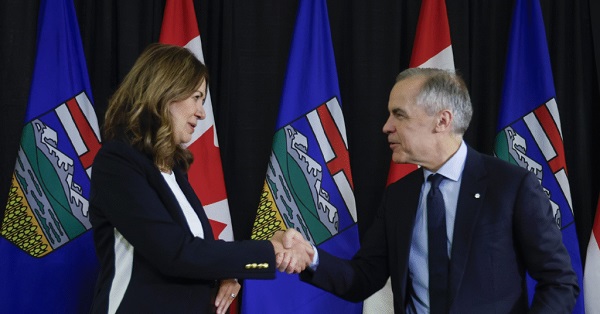International
The Cat Eaters of Ohio

The establishment media called it a racist myth, but is it?
Donald Trump shocked audiences at this week’s presidential debate with the claim that foreign migrants were eating household pets in Springfield, Ohio, a small town currently reeling under the strain of an unprecedented number of new arrivals, mostly from Haiti. “They’re eating the dogs,” Trump said. “They’re eating the cats.”
Reactions on both sides were spirited. Conservative social media accounts created memes that portrayed Trump, dressed in camouflage, and toting heavy weapons, as the savior of innocent pets. There was even a viral TikTok trend, which chopped up Trump’s speech and set it to dance music. “They’re eating the dogs, they’re eating cats,” the music thumped. “Eat the cat! Eat, eat the cat!”
The establishment media was not amused. During the debate, ABC’s David Muir dismissed Trump’s rhetoric with his version of a fact check, citing the Springfield city manager’s statement that “there have been no credible reports of specific claims of pets being harmed, injured, or abused by individuals within the immigrant community.” Other publications went further, blasting the former president for spreading a “racist smear,” a “century-old stereotype,” and a “cat-eating conspiracy theory.”
So, is there any truth to the charge? We have conducted an exclusive investigation that reveals that, yes, in fact, some migrants in Ohio appear to have been “eating the cats,” though not exactly in the manner that Trump described.
Our investigation begins in a run-down neighborhood of Dayton, Ohio, the closest major city to Springfield, about a half-hour’s drive away. We identified a social media post, dated August 25, 2023, with a short video depicting what appear to be two skinned cats on top of a blue barbeque. “Yoooo the Africans wildn on Parkwood,” reads the text, referring to Parkwood Drive. The video then pans down to two live cats walking across the grass in front of a run-down fence, with a voice on the video warning: “There go a cat right there. His ass better get missin’, man. Look like his homies on the grill!”
We spoke with the author of the video, who asked to remain anonymous but confirmed its time, location, and authenticity. He told us that he was picking up his son last summer, when he noticed the unusual situation. “It was some Africans that stay right next door to my kid’s mother,” he said. “This African dude next door had the damn cat on the grill.”
We then identified the home by matching it to the visuals in the video and cross-referencing it with the eyewitness. When we knocked on the door of the first unit, a family answered, telling us they were from the Democratic Republic of the Congo and that all of the surrounding units were occupied by other African migrants.
One of the residents told us that her former neighbors, also from Africa, had lived in the adjacent unit until last month. They had a blue grill and the father would find meat in the neighborhood. “Her dad was going to find meat,” she said. “Her dad was going, holding a knife.” The current residents also showed us a blue grill of the same make and model as in the video, which the former neighbors had abandoned after they moved out. There were at least ten cats wandering around the complex and another resident complained that they were breeding on the property.
According to the original witness, whose son was friendly with the neighbors, there was no doubt about what happened last summer. “They was barbecuing the damn cat!” he said. His son’s mother had previously witnessed the family butchering a mammal on the street, but the cats on the barbecue put him in such a state of shock, he felt the need to film it.
To be clear: this single incident does not confirm the particularities of Trump’s statement. The town is Dayton, not Springfield; cats alone were on the grill, not cats and dogs. But it does break the general narrative peddled by the establishment media and its “fact checkers,” who insisted that this has never happened, and that any suggestion otherwise is somehow an expression of racism.
It takes only a single exception, however, to falsify a hypothesis, and the logical next step, for any honest broker, is to ask if it is happening more often, and elsewhere. It is not implausible. Many developing nations, including the Congo and Haiti, have traditions of animal sacrifice or consumption of what Americans would consider household pets. And if this occurred in Dayton, where the migrant population is relatively small, it could be going on down the road in Springfield, where it is relatively much larger.
Independent journalists are already on the hunt and could reveal more. The Daily Wire has dispatched a reporter to Springfield to investigate. The Federalist has published a police report with allegations that a group of Haitians emerged from a city trail with dead geese in hand. Ohio’s attorney general, Dave Yost, has backed up this claim, arguing that citizens with such firsthand knowledge “would be competent witnesses in court.”
There is a legitimate debate to be had about migration and culture. All immigrants bring with them a particular tradition, which, in the case of countries such as Haiti and the Congo, can include practices that many Americans find disturbing. This cultural divide causes understandable consternation for non-migrants living in the rougher parts of places like Dayton and Springfield. They don’t enjoy the luxury of many in the establishment media, who can maintain a safe distance, condescending to those who raise the alarm while not even bothering to investigate anything themselves.
These revelations do not mean that assimilation is impossible, but the establishment will need to engage in a more honest debate, rather than simply smearing critics as racists and conspiracy theorists. One can make the case for migration, but one cannot, at the same time, deny that it comes with costs—which, in this case, seem to include a pair of flayed cats on a blue barbeque in Dayton, Ohio.
Christopher Rufo is a reader-supported publication. To receive new posts and support my work, consider becoming a free or paid subscriber.
Business
Warning Canada: China’s Economic Miracle Was Built on Mass Displacement

If you think the CCP will treat foreigners better than its own people, when it extends its power over you, please think again: Dimon Liu’s warning to Canadian Parliament.
Editor’s Note: The Bureau is publishing the following testimony to Canada’s House of Commons committee on International Human Rights from Dimon Liu, a China-born, Washington, D.C.-based democracy advocate who testified in Parliament on December 8, 2025, about the human cost of China’s economic rise. Submitted to The Bureau as an op-ed, Liu’s testimony argues that the Canadian government should tighten scrutiny of high-risk trade and investment, and ensure Canada’s foreign policy does not inadvertently reward coercion. Liu also warns that the Chinese Communist Party could gain leverage over Canadians and treat them as it has done to its own subjugated population—an implied message to Prime Minister Mark Carney, who has pledged to engage China as a strategic partner without making that position clear to Canadians during his election campaign.
OTTAWA — It is an honor to speak before you at the Canadian Parliament.
My testimony will attempt to explain why China’s economic success is built on the backs of the largest number of displaced persons in human history.
It is estimated that these displaced individuals range between 300 to 400 million — it is equivalent to the total population of the United States being uprooted and forced to relocate. These displaced persons are invisible to the world, their sufferings unnoticed, their plights ignored.
In 1978, when economic reform began, China’s GDP was $150 billion USD.
In 2000, when China joined the WTO, it was approximately $1.2 trillion USD.
China’s current GDP is approximately $18 trillion USD.
In 2000 China’s manufacturing output was smaller than Italy’s.
Today it’s larger than America, Europe, Japan, and South Korea combined.
If you have ever wondered how China managed to grow so fast in such a short time, Charles Li, former CEO of the Hong Kong Stock Exchange, has the answers for you.
He listed 4 reasons: 1) cheapest land, 2) cheapest labor, 3) cheapest capital, and 4) disregard of environmental costs.
“The cheapest land” because the CCP government took the land from the farmers at little to no compensation.
“The cheapest labor,” because these farmers, without land to farm, were forced to find work in urban areas at very low wages.
The communist household registration system (hukou 戶口) ties them perpetually to the rural areas. This means they are not legal residents, and cannot receive social benefits that legal urban residents are entitled. They could be evicted at any time.
One well known incident of eviction occurred in November 2017. Cai Qi, now the second most powerful man in China after Xi Jinping, was a municipal official in Beijing. He evicted tens of thousands into Beijing’s harsh winter, with only days, or just moments of notice. Cai Qi made famous a term, “low-end population” (低端人口), and exposed CCP’s contempt of rural migrants it treats as second class citizens.
These displaced migrant workers have one tradition they hold dear — it is to reunite with their families during the Chinese Lunar New Year holiday, making this seasonal migration of 100 to 150 million people a spectacular event. In China’s economic winter of 2025 with waves of bankruptcies and factory closures, the tide of unemployed migrant workers returning home to where there is also no work, and no land to farm, has become a worrisome event.
Historically in the last 2,000 years, social instability has caused the collapse of many ruling regimes in China.
“The cheapest capital” is acquired through predatory banking practices, and through the stock markets, first to rake in the savings of the Chinese people; and later international investments by listing opaque, and state owned enterprises in leading stock markets around the world.
“A disregard of environmental costs” is a hallmark of China’s industrialization. The land is poisoned, so is the water; and China produces one-third of all global greenhouse gases.
Chinese Communist officials often laud their system as superior. The essayist Qin Hui has written that the Chinese communist government enjoys a human rights abuse advantage. This is true. By abusing its own people so brutally, the CCP regime has created an image of success, which will prove to be a mirage.
If you think the CCP will treat foreigners better than its own people, when it extends its power over you, please think again.
The Bureau is a reader-supported publication.
To receive new posts and support my work, consider becoming a free or paid subscriber.
Artificial Intelligence
UK Police Pilot AI System to Track “Suspicious” Driver Journeys
AI-driven surveillance is shifting from spotting suspects to mapping ordinary life, turning everyday travel into a stream of behavioral data
|
|
-

 International2 days ago
International2 days agoAustralian PM booed at Bondi vigil as crowd screams “shame!”
-

 Uncategorized2 days ago
Uncategorized2 days agoMortgaging Canada’s energy future — the hidden costs of the Carney-Smith pipeline deal
-

 Automotive1 day ago
Automotive1 day agoCanada’s EV gamble is starting to backfire
-

 Alberta1 day ago
Alberta1 day agoAlberta Next Panel calls to reform how Canada works
-

 Digital ID15 hours ago
Digital ID15 hours agoCanadian government launches trial version of digital ID for certain licenses, permits
-

 Agriculture1 day ago
Agriculture1 day agoEnd Supply Management—For the Sake of Canadian Consumers
-

 Business14 hours ago
Business14 hours agoThe “Disruptor-in-Chief” places Canada in the crosshairs
-

 International15 hours ago
International15 hours agoWorld-leading biochemist debunks evolutionary theory








